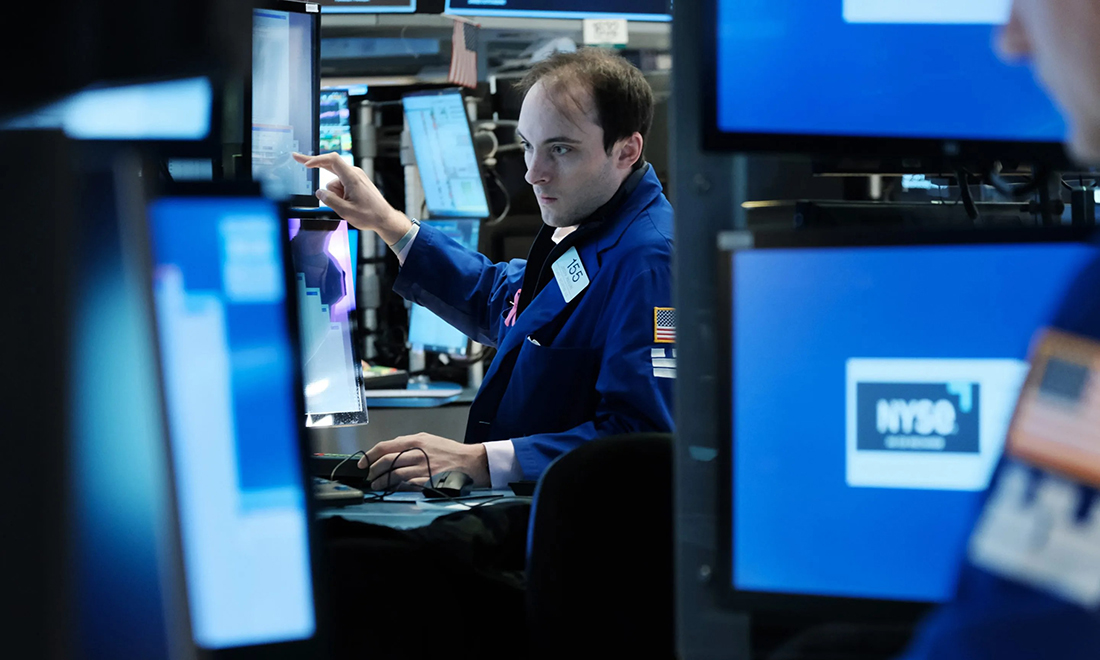
經(jīng)濟經(jīng)歷穩(wěn)定和脆弱的階段,,然后一場危機就會突然爆發(fā),。這就是圣路易斯華盛頓大學(Washington University in St. Louis)的前經(jīng)濟學教授海曼·明斯基在1986年所警告的:那些承擔了太多風險債務并允許投機性市場泡沫形成的經(jīng)濟體可能會面臨這樣的命運。幾十年后,,全球債務達到創(chuàng)紀錄的300萬億美元,,通貨膨脹現(xiàn)象頑固,銀行業(yè)發(fā)展不穩(wěn)定,,安聯(lián)(Allianz)的首席經(jīng)濟學家盧多維克·蘇布蘭開始擔心,,明斯基的預言即將成真。
他在今年5月8日告訴彭博社(Bloomberg):“我們已經(jīng)具備所謂明斯基時刻的所有要素,?!?/p>
明斯基于1996年去世,享年77歲,,他因其開創(chuàng)性的著作《穩(wěn)定不穩(wěn)定的經(jīng)濟》(Stabilizing an Unstable Economy)而聞名于世,,該書認為經(jīng)濟周期有五個常見的階段:正向沖擊、樂觀的繁榮,、非理性瘋狂,、獲利拋售及大恐慌。
在一個新的技術(shù)或模式,,例如低利率或互聯(lián)網(wǎng)使投資者興奮之后,,就會發(fā)生正向沖擊。媒體的關(guān)注和口口相傳就會造就與這個新現(xiàn)象相關(guān)的貸款和資產(chǎn)價格的繁榮,,這反過來又吸引了更多害怕被拋棄的投資者,,創(chuàng)造了一個興奮和冒險的時期。但最終,,隨著資產(chǎn)價格與現(xiàn)實脫鉤,,債務人努力償還貸款,一些投資者開始獲利,非理性瘋狂的情緒逐漸消失,。這導致了明斯基時刻的到來,,獲利行為變成了大恐慌,資產(chǎn)價格開始暴跌,。
明斯基認為,,經(jīng)濟無法避免經(jīng)歷繁榮-蕭條的周期,當金融家和投資者從貪婪的狂熱轉(zhuǎn)變?yōu)榭謶謺r,,他們就會變成經(jīng)濟破壞者,。我們已經(jīng)兩次看到他的理論成真,第一次是網(wǎng)絡(luò)泡沫后科技股的快速拋售,,然后是2008年全球金融危機期間房地產(chǎn)價格的崩潰,。
安聯(lián)的蘇布蘭于5月8日指出,另一個明斯基時刻可能到來的跡象是,,隨著銀行收緊貸款標準,,整個經(jīng)濟中的流動性逐漸消失。他警告說:“你到處都能看到這種情況,?!彼€指出,商業(yè)房地產(chǎn)是一個特別值得關(guān)注的領(lǐng)域,,該行業(yè)正在與不斷上升的空置率,、崩潰的價格和對違約的擔憂作斗爭。這個行業(yè)受到了向混合型工作轉(zhuǎn)變,,以及利率上升和地區(qū)銀行問題的影響,,這些問題讓獲得新貸款或舊貸款的再融資幾乎變得不可能。
蘇布蘭尤其擔心持續(xù)的高利率可能導致銀行業(yè)或來自非銀行貸款人(比如對沖基金和養(yǎng)老基金)發(fā)生更多的“金融事故”,,而這些非銀行貸款人則專注于陷入困境的商業(yè)房地產(chǎn)領(lǐng)域,。
“現(xiàn)在每個人面臨的問題都是突然的緊縮,隨后又多了一層錯誤的風險管理,?!彼傅氖欠倾y行貸款人的商業(yè)房地產(chǎn)貸款的潛在問題,這些貸款不受銀行的相同法規(guī)約束,。
蘇布蘭預計,,今年的貸款條件和獲得信貸的機會也將繼續(xù)下降,他說這將最終引發(fā)美國的經(jīng)濟衰退,。并且,,這不會是2008年全球金融危機的“翻版”,但市場拋售將在未來幾個月變得更加頻繁,。
蘇布蘭不是唯一擔心明斯基時刻的人,。摩根大通(JPMorgan Chase)的首席市場策略師和全球研究聯(lián)席主管馬爾科·科拉諾維奇在今年3月的一份說明中解釋稱,高通脹和利率上升增加了資產(chǎn)價格和貸款突然崩潰的可能性。
“市場和地緣政治出現(xiàn)明斯基時刻的可能性已經(jīng)增加,?!彼麑懙溃凹词怪醒脬y行家們成功地遏制了危機的蔓延,,由于來自市場和監(jiān)管機構(gòu)的壓力,,信貸條件將會更快地進一步收緊?!保ㄘ敻恢形木W(wǎng))
譯者:中慧言-項曦瑩
經(jīng)濟經(jīng)歷穩(wěn)定和脆弱的階段,然后一場危機就會突然爆發(fā),。這就是圣路易斯華盛頓大學(Washington University in St. Louis)的前經(jīng)濟學教授海曼·明斯基在1986年所警告的:那些承擔了太多風險債務并允許投機性市場泡沫形成的經(jīng)濟體可能會面臨這樣的命運,。幾十年后,全球債務達到創(chuàng)紀錄的300萬億美元,,通貨膨脹現(xiàn)象頑固,,銀行業(yè)發(fā)展不穩(wěn)定,安聯(lián)(Allianz)的首席經(jīng)濟學家盧多維克·蘇布蘭開始擔心,,明斯基的預言即將成真,。
他在今年5月8日告訴彭博社(Bloomberg):“我們已經(jīng)具備所謂明斯基時刻的所有要素?!?/p>
明斯基于1996年去世,,享年77歲,他因其開創(chuàng)性的著作《穩(wěn)定不穩(wěn)定的經(jīng)濟》(Stabilizing an Unstable Economy)而聞名于世,,該書認為經(jīng)濟周期有五個常見的階段:正向沖擊,、樂觀的繁榮、非理性瘋狂,、獲利拋售及大恐慌,。
在一個新的技術(shù)或模式,例如低利率或互聯(lián)網(wǎng)使投資者興奮之后,,就會發(fā)生正向沖擊,。媒體的關(guān)注和口口相傳就會造就與這個新現(xiàn)象相關(guān)的貸款和資產(chǎn)價格的繁榮,這反過來又吸引了更多害怕被拋棄的投資者,,創(chuàng)造了一個興奮和冒險的時期,。但最終,隨著資產(chǎn)價格與現(xiàn)實脫鉤,,債務人努力償還貸款,,一些投資者開始獲利,非理性瘋狂的情緒逐漸消失,。這導致了明斯基時刻的到來,,獲利行為變成了大恐慌,資產(chǎn)價格開始暴跌。
明斯基認為,,經(jīng)濟無法避免經(jīng)歷繁榮-蕭條的周期,,當金融家和投資者從貪婪的狂熱轉(zhuǎn)變?yōu)榭謶謺r,他們就會變成經(jīng)濟破壞者,。我們已經(jīng)兩次看到他的理論成真,,第一次是網(wǎng)絡(luò)泡沫后科技股的快速拋售,然后是2008年全球金融危機期間房地產(chǎn)價格的崩潰,。
安聯(lián)的蘇布蘭于5月8日指出,,另一個明斯基時刻可能到來的跡象是,隨著銀行收緊貸款標準,,整個經(jīng)濟中的流動性逐漸消失,。他警告說:“你到處都能看到這種情況?!彼€指出,,商業(yè)房地產(chǎn)是一個特別值得關(guān)注的領(lǐng)域,該行業(yè)正在與不斷上升的空置率,、崩潰的價格和對違約的擔憂作斗爭,。這個行業(yè)受到了向混合型工作轉(zhuǎn)變,以及利率上升和地區(qū)銀行問題的影響,,這些問題讓獲得新貸款或舊貸款的再融資幾乎變得不可能,。
蘇布蘭尤其擔心持續(xù)的高利率可能導致銀行業(yè)或來自非銀行貸款人(比如對沖基金和養(yǎng)老基金)發(fā)生更多的“金融事故”,而這些非銀行貸款人則專注于陷入困境的商業(yè)房地產(chǎn)領(lǐng)域,。
“現(xiàn)在每個人面臨的問題都是突然的緊縮,,隨后又多了一層錯誤的風險管理?!彼傅氖欠倾y行貸款人的商業(yè)房地產(chǎn)貸款的潛在問題,,這些貸款不受銀行的相同法規(guī)約束。
蘇布蘭預計,,今年的貸款條件和獲得信貸的機會也將繼續(xù)下降,,他說這將最終引發(fā)美國的經(jīng)濟衰退。并且,,這不會是2008年全球金融危機的“翻版”,,但市場拋售將在未來幾個月變得更加頻繁。
蘇布蘭不是唯一擔心明斯基時刻的人,。摩根大通(JPMorgan Chase)的首席市場策略師和全球研究聯(lián)席主管馬爾科·科拉諾維奇在今年3月的一份說明中解釋稱,,高通脹和利率上升增加了資產(chǎn)價格和貸款突然崩潰的可能性。
“市場和地緣政治出現(xiàn)明斯基時刻的可能性已經(jīng)增加,?!彼麑懙?,“即使中央銀行家們成功地遏制了危機的蔓延,由于來自市場和監(jiān)管機構(gòu)的壓力,,信貸條件將會更快地進一步收緊,。”(財富中文網(wǎng))
譯者:中慧言-項曦瑩
Stability, fragility, and then, suddenly, a crisis. That’s the fate that Hyman Minsky, a former economics professor at Washington University in St. Louis, warned in 1986 could be coming for economies that take on too much risky debt and allow speculative market bubbles to form. Decades later, with global debts touching a record $300 trillion and stocks rising in the face of stubborn inflation and banking instability, Allianz chief economist Ludovic Subran is worried Minsky’s prediction is about to come true.
“We have all the ingredients of a so-called Minsky moment,” he told?Bloomberg on May 8.
Minsky, who passed away in 1996 at 77, is known for his seminal book, Stabilizing an Unstable Economy (1986), which argued that there are five common stages of an economic cycle: displacement, boom, euphoria, profit-taking, and panic.
Displacement happens after a new technology or paradigm, like low interest rates or the internet, excites investors. Media attention and word of mouth then creates a boom in loans and asset prices related to this new phenomenon, which in turn draws in even more investors who fear being left behind, creating a period of euphoria and risk-taking. But eventually, the euphoria fades as asset prices untether from reality, debtors struggle to pay back their loans, and some investors begin to take profits. That leads to a Minsky moment, with profit-taking turning to panic and asset prices plummeting.
Minsky argued that economies can’t avoid these boom-bust cycles, when financiers and investors transform into economic annihilators as their frenzy of greed shifts to fear. And since then, we’ve seen his theory come true twice, first in the rapid sell-off of tech stocks after the dot-com bubble and then again when real estate prices collapsed during the global financial crisis of 2008.
Allianz’s Subran noted on May 8 that one sign that another Minsky moment could be coming is the fading liquidity across the economy as banks tighten their lending standards. “You see that everywhere,” he warned, pointing to commercial real estate, which is struggling with rising vacancy rates, collapsing prices, and fears of defaults, as a particular area of concern. The sector has been affected by the shift to hybrid work, as well as rising interest rates and regional banks’ issues that have made getting new loans or refinancing old ones nearly impossible.
Subran is particularly worried that continued high interest rates could lead to more “financial accidents” in the banking sector or from non-bank lenders, like hedge and pension funds, that focus on the ailing commercial real estate sector.
“Everybody’s problem now is the very abrupt tightening, but then there is an additional layer of wrong risk management,” he said, referring to potential problems with non-bank lenders’ commercial real estate loans that aren’t subjected to the same regulations as banks’.
Subran expects lending conditions and access to credit to continue falling this year as well, which he says will eventually help spark a U.S. recession. This won’t be a “remake of the global financial crisis” of 2008, he said, but market sell-offs will become more frequent over the next few months.
Subran isn’t the only one worried about a Minsky moment either. JPMorgan Chase’s chief market strategist and global research co-head, Marko Kolanovic, explained in a March note that high inflation and rising interest rates have increased the odds of a sudden collapse in asset prices and lending.
“The possibility of a Minsky moment in markets and geopolitics has increased,” he wrote. “Even if central bankers successfully contain contagion, credit conditions look set to tighten more rapidly because of pressure from both markets and regulators.”






